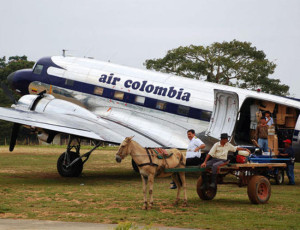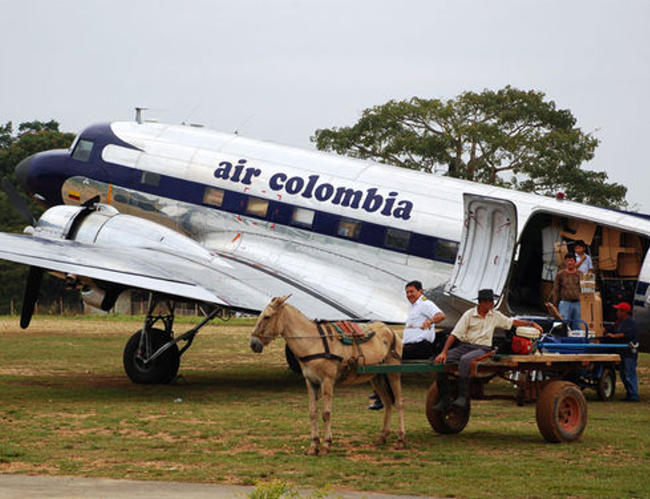Seventy-eight years after its first flight, the DC-3 continues to provide a vital service, supplying the most remote villages of Colombia with all types of goods.
INÍRIDA, Colombia – The most remote areas of the Colombian Amazon maintain contact with the rest of the world using the DC-3 airplane, a legendary aircraft that changed the history of aviation.

In the 1930s, the illustrious passengers of the new Douglas Commercial 3 celebrated the connection between New York and Los Angeles with exquisite banquets and cocktails.
Its versatility and low cost made it the first mass-produced airliner. More than 10,000 units were produced over the course of a decade, of which at least 100 remain in service throughout the world.
Most of the units were manufactured by women during World War II. On D-Day, these airplanes transported thousands of Allied soldiers to the beaches of Normandy. Two of the planes that took part in the largest military landing in history are still flying with Alianza Airlines, which operates out of Villavicencio, Colombia.
Seventy-eight years after its first flight, the DC-3 continues to provide a vital service.
As time passed, the DC-3 evolved from a symbol of comfort and luxury to a workhorse, handling jobs such as supplying the most remote villages of Colombia with everything they might need.
These planes have brought virtually everything to Taraira, a village of 200 people in the department of Vaupés.
“The street lights, the electrical generator, the cement, the only Jeep, the TV antennas, the TVs, a tractor, the panels used for the sports center, the chickens, the hens and the ice cream … everything,” said Capt. Joaquín Sanclemente, who has 33 years of experience flying the DC-3.
In the hangars of the airport in Villavicencio, a mid-sized city with 385,000 residents in the foothills of the Andes on the edge of the rainforest, there are 20 of these planes – probably the largest concentration of operational DC-3 aircraft at a single airport.
The airplanes were brought into the country by the Colombian airline Avianca. They were part of its fleet between 1939 and 1975 before they were sold to smaller airlines, where they began flying to hard-to-reach places.
Capt. Luis Felipe Cortés would need a considerable amount of time to make a list of the locations he had visited throughout Colombia during his 34-year career. His accumulated flight time totals a little under three years in the sky.
“It would be easier to tell you where we haven’t gone,” he said.
From Leticia in the Amazon to Cartagena on the Caribbean coast, and from Bahía Solano on the Pacific to Puerto Carreño on the banks of the Orinoco River, the DC-3 has crossed the skies of Colombia, providing a vital service that supports the survival of the country’s most remote communities.
The DC-3 is the lone aircraft capable of landing on the rudimentary runways made of dirt and sand – often maintained solely by the local residents using shovels during inclement weather.
“It’s like sticking a 12-ton tractor-trailer, going 150 kilometers per hour, into quicksand,” said Sanclemente, referring to landing on the runway in La Pedrera, a village in the department of Amazonas.
During a connecting stop on the Villavicencio-Barrancominas-Inírida route, a soldier in need of urgent medical attention approached the captain.
Sanclemente scratched his chin for a moment as he looked at his plane, loaded to the brim, as usual, and smiled. He ordered the mechanic to remove an amount of gasoline equivalent to the weight of the soldier and the soldier’s baggage, which they would collect on a return flight. The soldier boarded the plane.
The crew, in addition to the pilot and the co-pilot, always includes a mechanic, who inspects the plane after each landing and stays in the cabin while the plane is in flight, watching for any issues in need of attention.
Yet, these planes haven’t been involved in any serious accidents in decades.
“In the event that the two motors on the DC-3 fail, the plan can glide at a rate of 1.4 nautical miles for every 1,000 feet of altitude, providing a wide margin for emergency landings,” Sanclemente said.
The mechanics of Air Colombia airlines take down the motors on their aircraft after every 1,200 hours of flight, submitting them to tests involving X-rays, lenses, ultrasound, dye and other methods.
“Sometimes, it’s going so well that it seems a shame to take down the motors, but in aviation we don’t have the luxury of waiting for something to fail in order to inspect it,” mechanic Isidro González said.
In the larger settlements in the rainforest, there are longer, paved runways, allowing for the arrival of modern aircrafts that can carry more cargo.
But there will always be missions that only the DC-3 can handle.
“This is more than a business,” Sanclemente said. “It’s a public service. And we often have to be resourceful to meet the needs of the people, always paying attention to the cause and the measures being taken, without assuming unnecessary risks.”
Source: Infosurhoy

